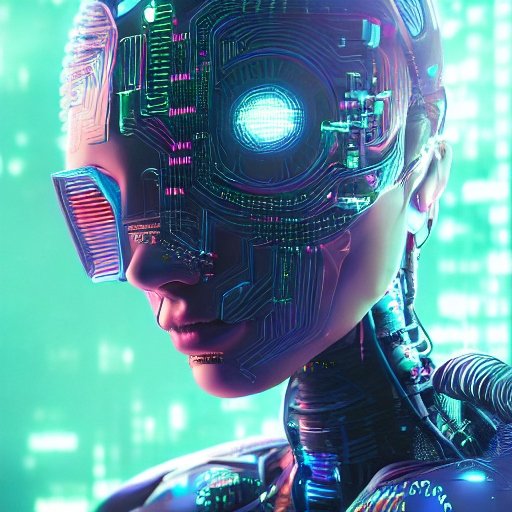Gain a comprehensive understanding of Artificial Intelligence (AI) with this beginner’s guide. Explore its concepts, applications, and societal impact in an accessible and engaging manner.
Introduction about AI
In today’s rapidly advancing technological landscape, the term “Artificial Intelligence” has become ubiquitous. From self-driving cars to voice-activated personal assistants, AI has permeated various aspects of our lives. But what exactly is Artificial Intelligence, and how does it work? This comprehensive guide aims to demystify AI for beginners, providing a clear understanding of its concepts, applications, and impact on society.

1. What is Artificial Intelligence?
Artificial Intelligence, often abbreviated as AI, refers to the simulation of human intelligence in machines that are programmed to think and learn like humans. AI encompasses a wide range of techniques and methodologies that enable machines to perform tasks that traditionally required human intelligence.
NoowAI – Free AI Assistant according Wikipedia.
Curious about Artificial Intelligence? Discover the fascinating world of AI and learn what it is, its applications, and its impact on various industries. Dive into the basics and demystify the concept of AI with this comprehensive beginner’s guide.
In today’s rapidly advancing technological landscape, one term that frequently dominates discussions is Artificial Intelligence (AI). From self-driving cars to voice assistants, AI has become an integral part of our lives. But what exactly is AI, and how does it work? In this beginner’s guide, we will demystify Artificial Intelligence, exploring its definition, applications, and potential impact on our world.
Understanding Artificial Intelligence
Defining Artificial Intelligence
At its core, Artificial Intelligence refers to the simulation of human intelligence in machines that are programmed to think, reason, and learn. AI systems are designed to perform tasks that typically require human intelligence, such as speech recognition, problem-solving, decision-making, and pattern recognition.
Types of Artificial Intelligence
There are two primary types of AI: Narrow AI and General AI. Narrow AI, also known as Weak AI, is designed to perform specific tasks within a limited domain, such as facial recognition or language translation. On the other hand, General AI, also known as Strong AI, aims to possess the same level of intelligence and cognitive abilities as humans, being capable of understanding, reasoning, and learning across various domains.
Machine Learning and Deep Learning
Machine Learning (ML) is a subset of AI that focuses on algorithms and statistical models that enable computers to learn and improve from experience without explicit programming. Deep Learning, a subfield of Machine Learning, utilizes artificial neural networks to simulate the functioning of the human brain, enabling systems to process vast amounts of data and make complex decisions.
Applications of Artificial Intelligence
Artificial Intelligence finds applications across various industries, transforming the way we live and work. Here are a few notable examples:
Healthcare
AI-powered diagnostic systems, personalized medicine, drug discovery, and robot-assisted surgeries are revolutionizing the healthcare sector, improving patient outcomes and streamlining processes.
Finance
AI algorithms facilitate fraud detection, credit scoring, algorithmic trading, and customer service chatbots, enhancing efficiency and accuracy in financial institutions.
Transportation
Self-driving cars, intelligent traffic management systems, and predictive maintenance solutions are some examples of how AI is shaping the transportation industry, leading to safer and more efficient journeys.
Retail
AI-driven recommendation engines, chatbots, inventory management systems, and virtual shopping assistants provide personalized experiences and improve customer satisfaction in the retail sector.
Education
AI-powered virtual tutors, personalized learning platforms, and intelligent content creation tools enhance the educational experience by tailoring materials and support to individual students’ needs.
The Impact of Artificial Intelligence
While AI offers tremendous potential, it also raises important considerations:
Job Displacement
The integration of AI technology may result in job automation and displacement. However, it is expected to create new job opportunities and drive economic growth in emerging AI-related fields.
Ethical Considerations
AI raises ethical concerns, such as privacy, bias, and accountability. Responsible development and deployment of AI systems require addressing these issues to ensure fairness, transparency, and protection of human rights.
Human-AI Collaboration
Rather than replacing humans, AI is more likely to augment human capabilities. Collaboration between humans and AI can lead to more efficient and innovative outcomes across various domains.
Artificial Intelligence represents a significant leap in the field of technology, promising to revolutionize industries and reshape our future. Understanding the fundamentals of AI, its applications, and the impact it can have on various sectors is crucial for anyone seeking to navigate the AI-driven world we live in.
NoowAI – Free AI Assistant.
2. The History and Evolution of AI

Artificial Intelligence has a rich history that dates back to ancient times. However, the development of AI as a formal discipline began in the mid-20th century. Here are some key milestones in the evolution of AI:
- The Dartmouth Workshop: In 1956, the Dartmouth Workshop marked the birth of AI as a field of study, bringing together researchers who shared the goal of creating machines that could mimic human intelligence.
- The AI Winter: Following initial optimism, the field of AI faced setbacks in the 1970s and 1980s, known as the “AI Winter,” as progress stagnated due to funding cuts and unmet expectations.
- The Rise of Machine Learning: In the late 1990s and early 2000s, advancements in machine learning, particularly with the development of neural networks, reignited interest and led to breakthroughs in AI applications.
- Deep Learning Revolution: Around 2010, deep learning emerged as a dominant approach within AI, fueled by the availability of big data, improved computing power, and sophisticated algorithms.
Read more about AI history: »The history of AI: from Turing to today
NoowAI – Free AI Assistant.
3. Types of Artificial Intelligence
Artificial Intelligence can be classified into various categories based on its capabilities and functionalities. The following are the main types of AI:
- Narrow AI: Also known as weak AI, Narrow AI focuses on performing specific tasks with high precision, such as voice recognition or image classification. Narrow AI is designed for specific purposes and lacks the general intelligence of humans.
- General AI: General AI, also referred to as strong AI or AGI (Artificial General Intelligence), aims to possess the ability to understand, learn, and perform any intellectual task that a human can do. However, achieving true General AI remains a significant challenge.
- Superintelligence: Superintelligence refers to an AI system that surpasses human intelligence in virtually every aspect. This concept is still largely theoretical and raises profound ethical and existential questions.
4. Machine Learning: The Backbone of AI
Machine Learning is a subset of AI that focuses on enabling machines to learn and make decisions without being explicitly programmed. It involves the development of algorithms that can analyze vast amounts of data, identify patterns, and make predictions or decisions based on the learned patterns.
5. Deep Learning: Unleashing the Power of Neural Networks
Deep Learning is a subfield of Machine Learning that utilizes artificial neural networks to model and simulate the complex workings of the human brain. It enables machines to process and understand vast amounts of unstructured data, such as images, texts, and sounds, leading to remarkable advancements in areas like image recognition, natural language processing, and speech synthesis.
6. Natural Language Processing: AI and Human Language
Natural Language Processing (NLP) focuses on enabling machines to understand and interact with human language. It involves tasks such as speech recognition, sentiment analysis, language translation, and chatbot development. NLP allows machines to comprehend, analyze, and generate human language, leading to applications like virtual assistants, language translation services, and automated customer support.
7. Computer Vision: AI and Image Recognition
Computer Vision combines AI algorithms and techniques to enable machines to interpret and understand visual information from images or videos. It involves tasks like image recognition, object detection, facial recognition, and scene understanding. Computer Vision finds applications in diverse fields, including autonomous vehicles, surveillance systems, medical imaging, and augmented reality.
8. AI in Everyday Life: Applications and Examples
Artificial Intelligence has permeated various aspects of our daily lives. Here are some notable applications of AI that we encounter in our everyday routines:
- Virtual Assistants: Voice-activated virtual assistants like Siri, Alexa, and Google Assistant provide us with information, perform tasks, and control smart home devices.
- Recommendation Systems: AI-powered recommendation systems analyze user preferences and behavior to suggest personalized content, such as movie recommendations on streaming platforms or product recommendations on e-commerce sites.
- Smart Home Automation: AI enables the automation and control of various devices in our homes, from thermostats and lighting systems to security cameras and appliances.
- Autonomous Vehicles: Self-driving cars utilize AI algorithms, sensors, and computer vision to navigate roads, detect obstacles, and make real-time driving decisions.
- Healthcare Diagnostics: AI algorithms assist in medical image analysis, aiding doctors in diagnosing diseases from X-rays, MRIs, and CT scans with greater accuracy.
9. The Ethical Considerations of Artificial Intelligence
As Artificial Intelligence continues to advance, it raises important ethical considerations. Here are some key areas of concern:
- Bias and Fairness: AI systems can inherit biases from the data they are trained on, leading to discriminatory outcomes or perpetuating existing biases in society.
- Privacy and Security: The extensive collection and analysis of personal data raise concerns about privacy infringement and the security of sensitive information.
- Job Displacement: The automation of tasks and the potential for AI to replace certain jobs raises concerns about unemployment and the need for re-skilling or upskilling the workforce.
- Accountability and Transparency: AI systems that make decisions impacting individuals or society should be transparent, explainable, and accountable for their actions.
10. The Future of Artificial Intelligence
The future of Artificial Intelligence holds immense possibilities and challenges. Here are some anticipated trends and developments:
- Continued Advancements in Deep Learning: Deep learning will continue to drive breakthroughs in AI, enabling more sophisticated applications in various domains.
- AI-Powered Healthcare: AI will play a crucial role in revolutionizing healthcare, from personalized medicine and drug discovery to remote patient monitoring and disease prediction.
- Enhanced Human-Machine Collaboration: AI will augment human capabilities, enabling collaborative systems where humans and machines work together seamlessly.
- Ethical AI Frameworks: Efforts will be made to establish ethical frameworks and guidelines for the development and deployment of AI systems, addressing concerns related to bias, fairness, and accountability.

FAQs about Artificial Intelligence
Q: Can AI replace human intelligence entirely?
A: While AI can perform specific tasks with remarkable efficiency, it lacks the holistic intelligence and adaptability of human beings.
Q: Will AI lead to job loss on a massive scale?
A: While AI has the potential to automate certain tasks and job roles, it is also expected to create new opportunities and transform industries. It is more likely to augment human capabilities rather than completely replacing human intelligence.
Q: Can AI become sentient and surpass human intelligence?
A: Achieving true artificial sentience, where AI possesses consciousness and self-awareness, remains a topic of speculation and debate among researchers. It is a complex challenge that is yet to be fully understood.
Q: Are there any limitations to AI?
A: AI has certain limitations, such as its reliance on data quality, potential biases in algorithms, and the inability to replicate complex human emotions and creativity. These limitations highlight the importance of human oversight and intervention.
Q: What are the ethical considerations of AI?
A: The ethical considerations of AI include issues of bias, privacy, security, job displacement, and accountability. It is crucial to address these concerns to ensure the responsible development and deployment of AI technologies.
Conclusion
Artificial Intelligence has become an integral part of our modern world, impacting various industries and transforming the way we live and work. Understanding the fundamentals of AI, its applications, and the ethical considerations surrounding its development is essential for both professionals and enthusiasts. By demystifying AI, we can embrace its potential while ensuring its responsible and beneficial integration into society.
As AI continues to evolve, it is the collective responsibility of researchers, policymakers, and individuals to shape its future in a way that benefits humanity as a whole.






